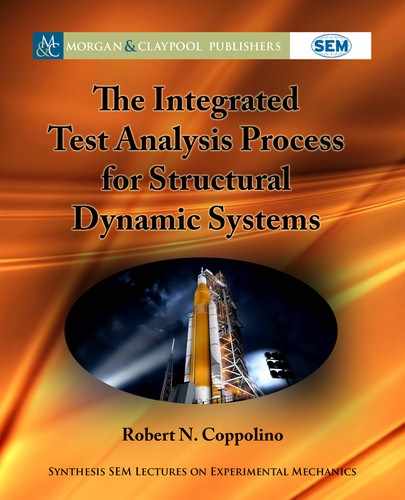Book Description
Over the past 60 years, the U.S. aerospace community has developed, refined, and standardized an integrated approach to structural dynamic model verification and validation.
One name for this overall approach is the Integrated Test Analysis Process (ITAP) for structural dynamic systems. ITAP consists of seven sequential tasks, namely: (1) definition of test article finite element models; (2) systematic modal test planning; (3) measured data acquisition; (4) measured data analysis; (5) experimental modal analysis; (6) systematic test-analysis correlation; and (7) reconciliation of finite element models and modal test data. Steps 1, 2, and 7 rely strictly on mathematical model disciplines, and steps 3 and 4 rely on laboratory disciplines and techniques. Current industry practice of steps 5 and 6 calls for interaction of mathematical model and laboratory disciplines, which compromises the objectivity of both modeling and laboratory disciplines. This book addresses technical content, strategies, and key relevant experiences related to all steps of ITAP, except for measured data acquisition which is the specialized domain of highly experienced laboratory professionals who contend with mechanical and electrical practicalities of instrumentation, excitation hardware, and data collection systems.
Table of Contents
- Preface
- Overview of the Integrated Test Analysis Process (ITAP)
- Definition of Test Article Finite Element Models
- Part 1: Variational Foundations of Modern Structural Dynamics
- Introduction
- Economy in Nature and Basic Variational Formulations
- Mathematical Physics and Hamilton's Principle
- The Contributions of Ritz, Galerkin, and Trefftz
- The Ritz Method
- Galerkin's Method
- Trefftz's Method
- Automated Formulations in Structural Dynamics
- The Finite Element Method
- Assembly of Linear Structural System Models
- System Models with Localized Nonlinearities
- Matrix Structural Analysis
- Free Vibration and Modal Analysis
- Uncoupled Structural Dynamic Equations
- Closure
- Part 2: Guidelines for Systematic Model Development
- Introduction
- Linear Single-Degree-of-Freedom Equations
- Linear Multi-Degree-of-Freedom Equations
- Normal Modes of Undamped MDOF Systems
- Response to Impulsive and Transient Force Excitations
- Response Spectrum and Shock Spectrum
- Illustrative Example: Half-Sine Pulse Force
- Illustrative Example: 1940 El Centro CA Ground Motion Data
- Definition of Relevant Structural Dynamic Models
- Illustrative Example: Aluminum Launch Vehicle and Spacecraft Components
- Illustrative Example: Aluminum Launch Vehicle Feedline
- Modal Density and the Effectiveness of Finite Element Models
- Illustrative Example: Fluid-Filled Circular Cylindrical Shell
- Free Surface Slosh Modes
- Interface Flexibility in Structural Assemblies—A Retrospective
- Damping in Structural Assemblies
- Closure
- References
- Part 1: Variational Foundations of Modern Structural Dynamics
- Systematic Modal Test Planning
- Part 1: Understanding Modal Dynamic Characteristics
- Part 2: Target Mode Selection
- Introduction
- Structure Excited by Boundary Accelerations and Applied External Loads
- Modal Effective Mass and Target Mode Selection
- Illustrative Example: ISS P5 Short Spacer
- Modal Gains and Target Mode Selection
- The Mode Acceleration Method and Target Mode Selection
- Illustrative Example: Axisymmetric Shell Finite Element Model
- Closure
- Part 3: Response DOF Selection for Mapping Experimental Modes
- References
- Measured Data Analysis
- Part 1: Preliminary Measured Data Analysis
- Introduction
- Key Preliminary Measured Data Analysis Functions, Mean, Variance, and Standard Deviation
- Normalized Probability Density and Ideal Gaussian Distribution
- Total Normalized Probability Function
- Autospectrum or Power Spectral Density Function
- Cross-Spectrum or Cross-Power Spectral Density Function
- The Spectrogram Function
- Illustrative Example: Sinusoidal Time History with Background Random Noise
- Illustrative Example: SDOF Linear System Response to Random Excitation
- Illustrative Example: ISPE Modal Test
- Illustrative Example: Wire Rope Test Article
- Illustrative Example: ISS P5 Modal Test
- Closure
- Part 2: Frequency Response Function Estimates from Measured Data
- References
- Part 1: Preliminary Measured Data Analysis
- Experimental Modal Analysis
- Systematic Test Analysis Correlation
- Part 1: Conventional Mass Weighted Correlation of Test and FEM Modes
- Part 2: Correlation of Test and FEM Modes Using Left-Hand Eigenvectors
- Introduction
- Modal Test Data Resulting from Estimated State-Space Models
- Theoretical System Modes in State-Space Form
- Correlation of Experimental and Theoretical Modes (Complex Least Squares)
- Illustrative Example: ISPE Modal Test
- Roadmap for a Highly Improved Integrated Test Analysis Process
- Closure
- References
- Reconciliation of Finite Element Models and Modal Test Data
- Author's Biography
- Blank Page (1/3)
- Blank Page (2/3)
- Blank Page (3/3)
